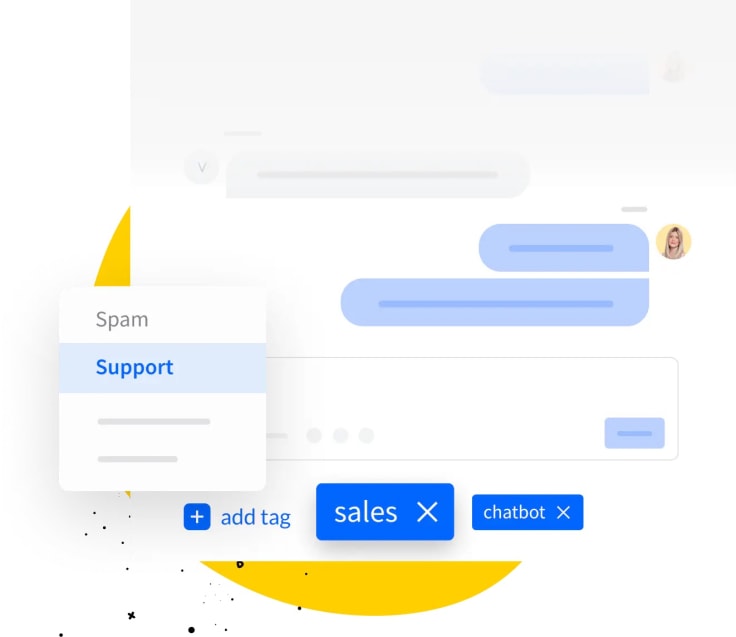Showing top 0 results 0 results found
Showing top 0 results 0 results found

Customer engagement has emerged as an ideal factor for companies that foster enduring relationships with their clients. While the traditional focus leaned towards delivering quality products or services, modern analytics underscore the significance of sustained engagement in influencing consumer behavior and choices.
The evolution of customer engagement reflects a broader shift in customer expectations and preferences. Historically, businesses primarily emphasized developing and delivering high-quality products or services as the cornerstone of their operations. While product quality remains essential, it has become clear that more than exceptional offerings are needed to secure long-term customer loyalty and advocacy.
Despite its growing prominence, customer engagement often needs to be revised in its definition for many enterprises. In today's hyper-connected and competitive marketplace, consumers are inundated with choices, prompting companies to differentiate themselves beyond mere transactions.
What is customer engagement?
Customer engagement embodies the continuous nurturing of interactions between a company and its consumers, transcending mere transactions. It entails the company's deliberate, consistent effort to deliver value at every touchpoint, fostering customer loyalty.
A nuanced understanding of customer engagement encompasses both quantitative metrics and qualitative dimensions. While metrics such as customer retention rates, repeat purchases, and net promoter score (NPS) provide quantitative insights into engagement levels, qualitative aspects measuring customer engagement delve deeper into the emotional and psychological connections forged between the brand and its customers.
Effective customer engagement entails cultivating a sense of belonging and community, wherein customers perceive themselves as valued stakeholders rather than passive recipients of products or services. This entails aligning the company's values and mission with the aspirations and preferences of its user target audience, thereby fostering resonance and affinity.
Why do you need a customer engagement strategy?
While the customer engagement metrics, satisfaction, and experience share common ground, they represent distinct facets of consumer-company dynamics. Customer satisfaction pertains to the degree of favorability consumers attach to a product, service, or experience. It is often measured through surveys, feedback forms, and customer reviews, reflecting customers' perceptions of the value delivered relative to their expectations.
Customer experience, on the other hand, covers all interactions and touchpoints that a customer encounters throughout their journey with the brand. It includes pre-purchase interactions, such as browsing products or researching options, and post-purchase interactions, including customer support and follow-up communications. Customer experience is shaped by usability, accessibility, responsiveness, and consistency across channels.
Conversely, customer engagement encompasses active listening and personalized solutions, elevating the interaction beyond satisfaction. It fosters two-way communication and dialogue, wherein customers feel heard, understood, and valued by the company. Customer engagement platforms involve proactively anticipating and addressing customer needs, preferences, and pain points, fostering deeper connections and loyalty.
Customer engagement strategy
A robust customer engagement strategy is a feedback mechanism, enabling companies to cultivate loyalty while gleaning invaluable consumer insights. By leveraging these insights, businesses can refine marketing approaches, streamline sales processes, lower customer acquisition costs, and enhance overall brand experiences. Since customers prioritize experiences alongside products and services, the imperative for a well-defined engagement strategy becomes evident.
A comprehensive customer engagement strategy consists of various elements, each tailored to address specific customer journey stages and touchpoints across different channels. Central to this strategy is cultivating a customer-centric culture, wherein all employees are aligned and empowered to prioritize user needs and deliver exceptional experiences.
Moreover, a data-driven approach is essential for optimizing engagement efforts and measuring their effectiveness. By leveraging user data and analytics, companies can gain actionable insights into user behavior, preferences, and trends, enabling personalized and targeted engagement initiatives.
Strategies for effective customer engagement
Customer engagement is crucial for businesses to foster loyalty, drive users, and enhance brand reputation. Employing the right strategies to manage customer engagement can significantly impact customer satisfaction and retention.
Here are key strategies for maximizing customer engagement:
1. Proactive communication
Proactive customer communication involves reaching out to users before they initiate contact, either through automated messages or personalized chats. You can use LiveChat to facilitate immediate interactions and convert leads into customers by employing pre-set messages or initiating personalized chats upon visitors' arrival.
Automated messages
Use LiveChat’s canned responses to automate engagement, greet visitors, and offer assistance based on predefined triggers. These messages can be tailored to specific scenarios, such as welcoming new visitors, promoting ongoing promotions, or addressing common inquiries.

Personalized chats
Initiate personalized chats with visitors based on their browsing behavior or previous interactions. By proactively engaging with customers, businesses can provide timely assistance, address concerns, and guide them through purchasing, ultimately improving conversion rates.
2. Multichannel integration
Incorporating multichannel integration allows businesses to extend their customer support efforts across various communication platforms, catering to customers' preferred channels and enhancing accessibility.
The LiveChat integration with platforms like WhatsApp Business, Messenger, and Apple Messages for Business provides seamless communication and better engagement.
WhatsApp Business integration
Enable customers to connect with your business through WhatsApp, a widely used messaging platform. By integrating LiveChat with WhatsApp Business, companies can provide real-time support, answer queries, and extensively build stronger customer relationships on their platform.
Facebook Messenger integration
Integrate LiveChat with Facebook Messenger to engage with customers directly through social media. By offering support via Messenger, businesses can reach a broader audience, leverage rich media features, and provide personalized assistance, driving engagement and increasing customer satisfaction.

Apple Messages for Business integration
Extend customer support to Apple users by integrating LiveChat with Apple Messages for Business. This integration allows businesses to engage with users through iMessage, offering convenient support options and enhancing the overall customer experience for iOS users.
3. Ecommerce integration
Ecommerce integration enhances the shopping experience and drives sales through LiveChat.
By integrating LiveChat with leading ecommerce platforms, businesses can offer in-chat product recommendations, provide real-time assistance, and streamline purchasing, ultimately increasing conversions and revenue.
Product recommendations
Leverage LiveChat's integration with ecommerce platforms to offer personalized product recommendations during chat interactions. By analyzing customer preferences and browsing history, businesses can suggest relevant products, upsell or cross-sell items, and enhance the overall user experience.
Real-time assistance
Provide real-time assistance to customers during the purchasing process, addressing any concerns. By offering immediate support through LiveChat, businesses can alleviate doubts, overcome objections, and guide customers toward completing their transactions, resulting in higher conversion rates and reduced cart abandonment.
4. Automation
Automation is crucial in streamlining customer interactions and improving response times, enhancing efficiency and customer satisfaction. LiveChat offers AI-powered automation features such as AI Assist and Chat Summary, which enable businesses to automate repetitive tasks, resolve inquiries more efficiently, and deliver a seamless customer experience.
AI Assist
Utilize AI-powered chatbots to handle routine inquiries, provide instant responses, and assist customers 24/7. By leveraging AI Assist, businesses can automate repetitive tasks, such as answering FAQs, scheduling appointments, or processing simple transactions, freeing human agents to focus on more complex issues and providing faster resolutions to customers.
Chat Summary
Enhance efficiency and productivity with Chat Summary, a feature that provides a comprehensive overview of chat interactions. By automatically summarizing chat conversations, including critical points, customer inquiries, and actions taken, businesses can quickly review past interactions, identify trends, and prioritize follow-up tasks, improving responsiveness and customer satisfaction.
5. Data-driven insights
Harnessing data-driven insights is essential for optimizing customer engagement strategies and making informed business decisions. LiveChat's reporting capabilities help measure the right customer service metrics, allowing businesses to derive actionable insights, track performance, and continuously improve customer engagement.

Reporting capabilities
Utilize LiveChat's reporting capabilities to track key metrics such as chat volume, response times, customer satisfaction scores, and conversion rates. By analyzing these metrics, businesses can identify trends, monitor user performance, and make data-driven adjustments to improve efficiency and effectiveness.
Actionable insights
Derive actionable insights from chat transcripts, customer feedback, and performance metrics to identify improvement areas and innovation opportunities. By understanding customer preferences, pain points, and behavior patterns, businesses can tailor their engagement strategies, refine their messaging, and deliver more personalized experiences.
Effective customer engagement is a continuous process that requires proactive communication, multichannel integration, ecommerce support, automation, and data-driven insights. By implementing these strategies and leveraging LiveChat's capabilities, businesses can enhance customer effort score and user satisfaction, drive sales, and build lasting customer relationships in today's competitive landscape.
Benefits of successful customer engagement

Successful customer engagement goes beyond merely driving sales; it includes a multitude of advantages that fortify your brand's position for long-term success and enhance return on investment.
By leveraging proven tools and best practices, companies can devise and execute customer engagement strategies that yield the following significant benefits:
1. Improves customer relationships
Maintaining meaningful customer relationships has become increasingly challenging despite the myriad technological advancements that facilitate outreach and marketing efforts. While technology enables businesses to reach new leads, nurturing ongoing customer relations requires a concerted effort.
Regular communication across various platforms is the cornerstone for building customer rapport. Effective engagement strategies extend beyond the point of purchase, catering to consumers' needs from initial awareness through the entire purchasing journey and beyond.
Companies can foster trust and build customer loyalty by actively engaging with users and addressing their inquiries and concerns, laying the groundwork for enduring relationships.
2. Boosts loyalty and customer retention
A well-executed engagement strategy enables companies to gain insights into customer expectations, sentiments, preferences, and areas for improvement. Companies can enhance the overall user experience and mitigate churn risk by soliciting feedback and actively listening to customer concerns.
Users who feel valued and appreciated are likelier to exhibit brand loyalty and make repeat purchases. By demonstrating genuine interest in their customers' well-being and satisfaction, companies position themselves as trusted partners rather than mere vendors, fostering long-term customer loyalty programs and advocacy.
3. Uncovers up-sell opportunities
Building a loyal customer base provides companies with fertile ground for promoting additional products or services with enhanced features. Selling to existing users is simpler and more cost-effective than acquiring new leads.
Utilizing consumer trends and data analytics, businesses can identify cross-selling and up-selling opportunities, such as recommending complementary products or upgrades based on past purchase behavior. By leveraging customer insights, companies can tailor their offerings to meet evolving needs and preferences, driving incremental revenue and profitability.
4. Streamlines purchase cycles
Customer engagement streamlines the purchase journey by leveraging technology and data-driven insights to automate interactions and personalize experiences. By harnessing AI-driven platforms, businesses can automate routine tasks, anticipate customer needs, and deliver timely responses, expediting conversion.
Detailed analytics provide visibility into account activity and sales performance, enabling companies to retarget potential customers and optimize sales strategies. Streamlining the purchase cycle enhances the overall customer experience and empowers sales teams to focus on value-added activities like innovation and customer relationship re-building.
5. Increases user base
Consistent engagement efforts are pivotal in attracting and retaining customers and expanding the user base. While discounts and promotions may attract initial interest, providing valuable content tailored to customers' needs and interests fosters sustained engagement and brand affinity.
By delivering relevant and insightful content, companies can position themselves as trustworthy authorities in their respective domains, driving customer acquisition and retention. A data-driven approach enables companies to determine the optimal frequency and channel mix for engaging with their audience to maximize the effectiveness of their engagement efforts.
Successful customer engagement drives immediate sales and lays the foundation for long-term relationships, loyalty, and sustainable growth. By prioritizing customer-centric strategies and leveraging technology to enhance interactions, companies can unlock the full potential of customer engagement and realize tangible business benefits.
Customer engagement vs. customer experience (CX) vs. customer satisfaction

Despite their interconnected nature, each concept contributes distinct insights and outcomes to the overarching sales strategy, necessitating a deeper exploration of their intricacies.
1. Customer experience vs. customer engagement
Customer experience transcends individual transactions, encompassing interactions between a customer and a brand. It embodies the essence of the brand's identity, from captivating marketing campaigns to the seamless navigation of digital platforms and the immersive ambiance of physical stores.
At its core, CX entails understanding the brand through the lens of the customer, striving to orchestrate an environment that resonates with their aspirations and preferences.
In contrast, customer engagement delves into the dynamic interplay between the brand and the customer across diverse channels and touchpoints. It extends beyond passive observation, covering consumers' active involvement and participation in the brand experience. From lively social media interactions to enthusiastic email subscriptions, customer engagement platforms reflect the depth of connection and resonance between the customer and the brand.
2. Navigating customer satisfaction vs. customer engagement
Customer satisfaction is a metric that gauges the extent to which a customer's expectations are met or exceeded throughout their journey with the brand. It encapsulates the culmination of their interactions, reflecting their overall contentment with the experience. While a customer satisfaction score is essential for fostering loyalty and advocacy, it represents a retrospective evaluation of past interactions rather than an ongoing dialogue.
Conversely, customer engagement operates on a dynamic continuum, comprising the ongoing dialogue and relationship-building efforts between the brand and the customer. It transcends individual transactions, fostering sustained interactions and connections beyond mere satisfaction. From personalized interactions to proactive outreach initiatives, customer engagement campaigns catalyze deeper bonds and brand affinity, driving long-term loyalty and advocacy.
By elucidating the nuances between customer engagement, experience, and satisfaction, businesses can devise more nuanced and targeted customer engagement marketing strategies tailored to their unique objectives and customer demographics. While CX lays the foundation for immersive brand experiences, engagement catalyzes active participation and dialogue, fostering deeper connections and affinity.
Ultimately, satisfaction emerges as the culmination of these efforts, reflecting the holistic impact of customer-centric initiatives on long-term loyalty and advocacy. By aligning strategies to address each facet of the customer life cycle – from shaping memorable experiences to fostering meaningful engagements and nurturing satisfaction – businesses can forge enduring bonds with their customers, driving sustained growth and success.
What does customer engagement look like?
Understanding customer engagement is pivotal for businesses that foster meaningful connections with their audience. While it manifests in diverse forms and contexts, customer engagement encompasses a spectrum of online and offline interactions.
Let's delve into the multifaceted nature of customer engagement to decipher its nuances and implications for modern businesses.
1. General and selective engagement
Customer engagement is not a one-size-fits-all phenomenon. Instead, it manifests at various levels and intensities depending on the individual preferences and behaviors of the audience.
Some customers may engage with a business at the product level, forging connections within specialized communities or forums dedicated to specific interests or purchases. For instance, a new car buyer might join a Facebook group exclusive to Mustang enthusiasts, fostering camaraderie and exchange within a niche community.
Conversely, engagement may transcend product-specific interactions and extend to the broader brand identity. Apple aficionados exemplify this selective engagement, exhibiting unwavering loyalty and affinity towards the brand beyond individual product offerings. Such brand-centric engagement underscores the emotional resonance and cultural significance that brands can evoke among their devoted followers.
While some customers engage with specific products or services, others form deep connections with the overarching brand ethos and values, shaping their engagement behaviors accordingly.
2. Online and offline dynamics
The landscape of customer engagement is not confined to digital channels. It covers a seamless integration of online and offline interactions, contingent upon the nature of the business and its offerings. In traditional retail models, where transactions occur discreetly, customer engagement is important and may occur sporadically or absent altogether. However, in ecommerce and digital commerce, engagement is inherent to the online experience, permeating every stage of the customer journey.
Moreover, customer engagement may intertwine with the usage of the product or service itself, blurring the boundaries between consumption and interaction. In such instances, the salient question shifts from whether customers engage to the qualitative nature of those moments, emphasizing the depth of connection and significance of the customer experience.
For example, consider a scenario where a customer purchases a smart home device. Beyond the initial transaction, engagement extends to the interaction with the device, troubleshooting assistance, and participation in user forums or communities dedicated to sharing tips and experiences. In this way, the product usage becomes a catalyst for ongoing engagement, enriching the customer experience beyond the point of sale.
Practical examples of engagement
- Making a complaint: Dissatisfied customers vocalize their grievances through public forums or direct communication channels, signaling a critical juncture in the customer-brand relationship. Effectively addressing complaints presents an opportunity to bridge the experience gap and cultivate loyalty through responsive and empathetic resolution.
- Responding to marketing on social media: Engaged customers may spontaneously comment on marketing materials, sharing insights, experiences, or inquiries with their social circle. These interactions serve as potent forms of social proof, influencing perceptions and fostering dialogue between customers and the brand.
- Reviewing on third-party sites: Customers express their sentiments and experiences through online reviews, shaping perceptions and informing prospective buyers. While negative reviews pose challenges, they offer valuable feedback for improvement and mitigation strategies.
- Participation in loyalty programs: Enrolling in loyalty programs signifies a commitment to the brand, driven by the allure of rewards and incentives. Loyalty programs cultivate enduring relationships and bolster customer retention by incentivizing repeat purchases and fostering exclusivity.
- Contributing ideas and suggestions: Engaged customers actively participate in brand communities, offering insights, suggestions, and requests for product enhancements or offerings. These contributions reflect a sense of ownership and investment in the brand's evolution, fostering co-creation and innovation.
- Utilizing online support: Seeking assistance or guidance through customer service channels demonstrates a vested interest in optimizing the product or service experience. Responsive and personalized support enhances customer satisfaction and loyalty, fortifying the bond between the customer and the brand.
Conclusion
Beyond these examples, some customers transcend mere engagement, integrating the brand into their lifestyle or belief system. Conversely, disengaged customers may exhibit passive or negative attitudes towards the brand, influenced by external perceptions or rival offerings.
Understanding these diverse customer personas is crucial for tailoring engagement strategies and fostering authentic connections that resonate with the target audience.
In essence, customer engagement embodies a dynamic interplay of interactions and sentiments that underpin the customer-brand relationship. Businesses can nurture loyalty, advocacy, and sustainable growth in an ever-evolving marketplace by cultivating meaningful engagement across online and offline touchpoints.








Comments